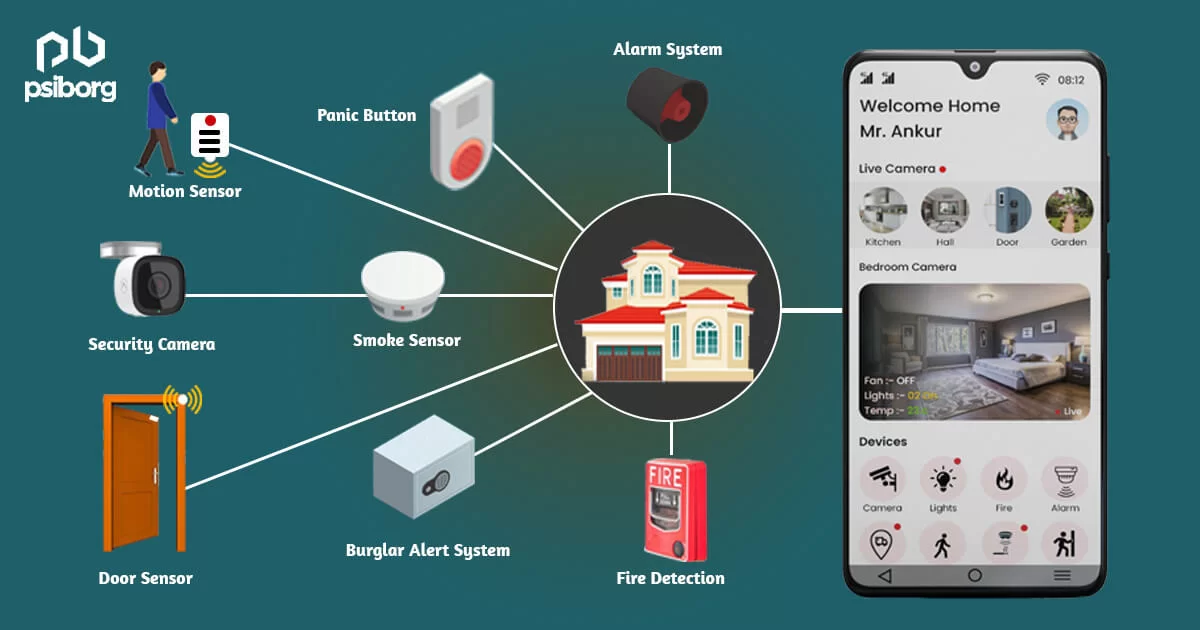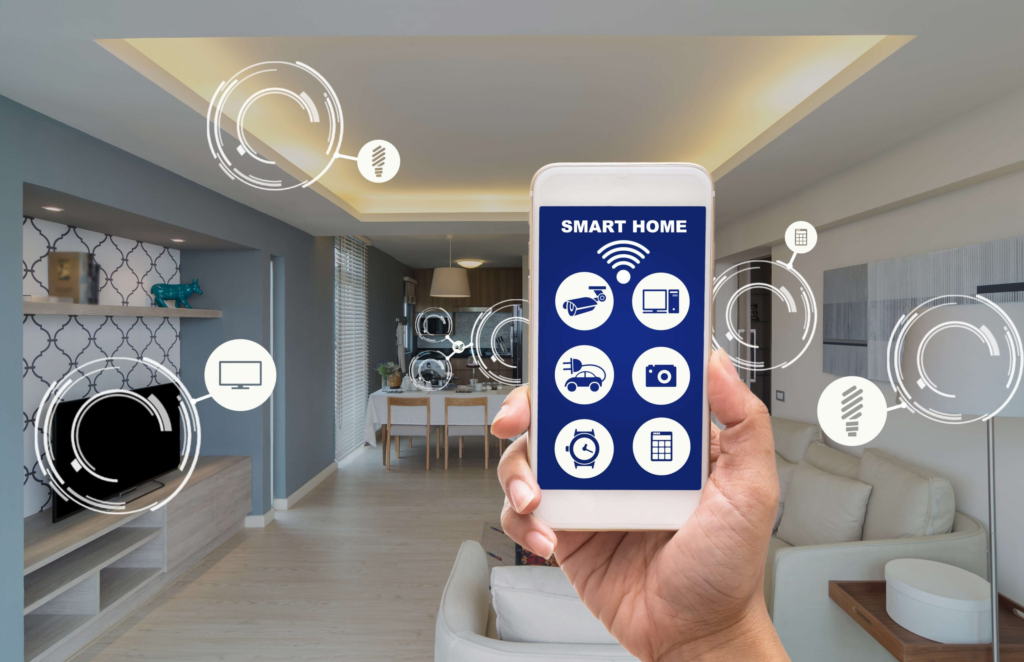Owning a smart home or a smart home system is one of the goals you want to have in this time and age, for this can help eliminate the boring, old-fashioned appliances. Smart home systems can aid one’s life and even enhance one’s social circle. Today’s technology has made our daily lives easier, and why should you not opt for a smart home?
For us at Logic Science Security Systems Limited, we are here to guide you on your smart home system installation. So, sit back and pay attention as we delve into the details in the ensuing sections.

What Is a Smart Home System?
Before we dive into the installation intricacies, what is a smart home or smart home system? A smart home system combines information and communications technology, wireless sensor networks, and automation for controlling and managing various household functions such as lighting, climate, security, and entertainment through remote monitoring and control.
Before going for a smart home system, you have to consider your budget, the type of application, and the devices that you want to install in your home—is it a cheap and yet reliable device or a high and expensive type? Do you want to start simple or do you want to go all out for it?
Devices such as lights, thermostats, security systems, and appliances are controlled by a master home automation controller, often called a smart home hub. This hub is a hardware device that acts as the central point of the smart home system and can sense, process data, and communicate wirelessly.
It combines all the appliances into a unit of a single smart home appliance that owners can control remotely. Examples of smart home hubs include Amazon Echo, Google Home, and Wink Hub. While many smart home products use Wi-Fi and Bluetooth devices to connect to the smart home network, others depend on wireless protocols or a local internet provider.
In the next section, we will explore some basic info needed in installing a smart home system.
Smart Home System Installation
A smart home’s devices are connected with one another and can be accessed through a central hub or a central point, or even with a smartphone, tablet, laptop, or game console. Door locks, televisions, thermostats, home monitors, cameras, lights, and appliances such as the refrigerator can be controlled through a hub.
The system is installed on a phone, Wi-Fi, or other networked device, and the user can schedule the performance of tasks on the central hub.
In trying to install smart home appliances, we must understand that every smart home system comes with self-learning skills or guides. Every owner of a smart home system can adjust it to suit their needs and schedules.
There are loads of benefits that come with smart home systems, including lighting control, which ultimately culminates in the reduction of energy consumption. This saved energy can then be channeled to other devices. Also, users can schedule their washing machine, coffee machine, and heater tailored to their lifestyle.
Some home automation systems alert the homeowner if any motion is detected in the home when they’re away. Others can call the authorities—the police or the fire department—if dangerous situations arise.
Once connected, services such as a smart doorbell, smart security system, and smart appliances become part of the connected internet technology, a network of physical objects that can gather and share electronic information.
Now, let’s check out the steps involved in installing smart home systems.
Steps to Installing Smart Home Systems for a Beginner
You have learned about smart home systems and the convenience they bring. In this section, we will explore the steps involved in installing one in your apartment.
1. Define Your Goals
Before starting, the first thing you want to do is determine what you want from your smart home. Are you aiming for better security, improved energy efficiency, or enhanced convenience? Establishing clear objectives will help you select the right devices and ecosystem to match your needs.
2. Choose a Smart Home Ecosystem
Now that you know what you want, you want to make sure you select the right smart home ecosystem for your needs. In case you don’t know what a smart home ecosystem is, it allows devices to communicate and work together.
You can select a platform such as Apple HomeKit, Amazon Alexa, Google Assistant, or Samsung SmartThings based on your preferences and existing devices to ensure smooth integration.
3. Check Connectivity Compatibility
Smart devices rely on different communication protocols like Wi-Fi, Bluetooth, Zigbee, and Z-Wave. Ensure that your selected devices are compatible with your chosen ecosystem and can connect seamlessly to avoid integration issues.
4. Start with Essential Devices
Begin by installing fundamental smart home gadgets that provide the most impact, such as:
- Smart Lighting – Control lights remotely and set automation based on schedules or motion detection.
- Smart Thermostat – Adjust your home’s temperature automatically based on usage patterns for energy savings.
- Smart Plugs – Upgrade regular appliances by plugging them into smart outlets that enable remote control.
- Smart Speakers – These not only function as voice assistants but can also act as central controllers for your devices.
5. Improve Home Security
Enhance safety by adding smart locks, video doorbells, surveillance cameras, and motion sensors. These features provide remote monitoring, real-time alerts, and greater control over access to your home.
6. Enhance Entertainment and Comfort
Incorporate smart TVs, speakers, and streaming devices for an upgraded entertainment experience. You can also automate window blinds, air conditioning, and lighting to create a comfortable and energy-efficient environment.
7. Set Up Automation and Routines
Maximize efficiency by creating automated routines. For example, program your lights to dim at bedtime or set your thermostat to adjust when you leave the house. These automations help streamline daily tasks and enhance convenience.
8. Secure Your Smart Home
Protect your devices with strong passwords and enable two-factor authentication where possible. Keep software updated to safeguard against security vulnerabilities and ensure a reliable smart home system.
By following these steps, you can build a smart home that enhances convenience, security, and energy efficiency. Start small, expand gradually, and enjoy the benefits of a fully connected living space.
In the next section, we will explore some of the equipment behind the functioning of smart home systems—smart home security systems.
Smart Home Security System
A smart home security system is a group of physical electronic components that all work together to protect a home. Often, a home security system will consist of the following objects:
- Glass break sensor
- Siren
- Keypad
- Security camera
- Motion sensor
- Entry sensor

Glass break sensor
Sometimes, to avoid setting off the entry sensors, intruders simply break open windows instead of opening them the traditional way. However, a glass break sensor also detects the sound of glass breaking and alerts us via mobile notification.
Siren
Sirens exist in home security systems both on their own and as part of other devices, such as the base station (which we’ll get to below). Sirens often go off at the same time as other alarms and are intended to scare intruders away or alert our neighbors.
Keypad
To arm or disarm, security systems commonly require a code, which we enter on a keypad that’s mounted to the wall or placed on a flat surface.
Security camera
Smart cameras hook up to Wi-Fi, enabling us to livestream footage of our system remotely and receive notifications when our cameras detect movement, people, or packages. Many cameras include infrared, cloud or local storage, and two-way audio, which allows us to speak to whoever is on camera. Some cameras also have smart platform integrations such as Amazon Alexa or Google Assistant.
Motion sensor
Motion sensors should be placed in a main entryway or hallway on the ground floor of a home so that they can detect motion and alert us when our system is armed. Some motion sensors are sensitive to pets, so they don’t go off every time our dog walks by.
Entry sensor
Also known as contact sensors, entry sensors have two parts: one that goes on the window or door and another that goes on the frame.
These sensors use magnets to determine when one of these entrances is opened or closed. If the sensor thinks an entry point is open, it alerts the homeowner. We suggest placing entry sensors on windows or doors on the ground floor. The majority are battery-operated, and many even have adhesive backings for easy installation.
Benefits of Smart Home Security Systems
In this section, we will examine the benefits of opting for the smart home systems option.
1. Enhanced Protection for Your Home and Belongings
A smart security system acts as a strong deterrent against potential break-ins. Features such as surveillance cameras, motion sensors, and smart locks provide real-time monitoring and alerts, helping prevent theft before it happens. If a break-in does occur, the system records crucial evidence, increasing the chances of recovering stolen items and identifying culprits.
2. Remote Access and Control
One of the biggest advantages of smart home security is the ability to monitor and manage your home from anywhere. Whether you’re at work or on vacation, you can check security camera footage, lock or unlock doors, and receive instant notifications of any suspicious activity directly on your smartphone or computer.
3. 24/7 Security and Automation
Unlike traditional security systems that need to be manually activated, smart security systems operate continuously. Many are equipped with motion detection and can send emergency alerts if they detect unusual movement, ensuring your home remains protected at all times.
4. Seamless Integration with Smart Home Devices
Smart security systems work well with other automated devices like smart lights, thermostats, and voice assistants. This allows you to create routines such as turning on lights when motion is detected or setting an automated security mode when you leave home, enhancing both security and convenience.
5. Lower Insurance Costs
Many insurance providers offer discounts to homeowners who install smart security systems. Since these systems reduce the risk of burglary, fire, and water damage, insurers often provide lower premiums, helping you save money in the long run.
6. Increased Energy Efficiency
Some smart security systems also contribute to energy savings by integrating with other smart home features. For example, they can adjust lighting and heating based on occupancy, preventing unnecessary energy use and reducing utility bills.
7. Greater Peace of Mind
Knowing that your home is continuously monitored brings a sense of security. Whether it’s protecting your family, pets, or valuables, a smart security system ensures that your home remains safe, even when you’re away.
By investing in a smart home security system, you not only safeguard your property but also enhance convenience, efficiency, and overall home value.
Disadvantages of Smart Home Security Systems
In this section, we will examine some of the downsides to using smart home security systems.
1. Complexity and Learning Curve
For those unfamiliar with smart technology, setting up and managing a smart security system can be challenging. Many devices require configuration, app synchronization, and an understanding of automation features, which may necessitate training or technical assistance.
2. Compatibility Issues
Not all smart security devices work seamlessly together, especially if they come from different manufacturers. Ensuring compatibility between cameras, alarms, motion sensors, and other smart home components can sometimes be a challenge.
3. Vulnerability to Cyber Threats
One of the biggest concerns with smart home security is the risk of hacking. If cybercriminals gain access to your system, they could disable alarms, unlock doors, or manipulate security settings, compromising the safety of your home. Strong passwords, encryption, and regular software updates are essential to mitigate these risks.
4. Privacy Concerns
Smart security systems often collect and store data, including video footage, access logs, and user behavior. This information may be accessible to manufacturers and third-party platforms, raising concerns about data privacy. Users must trust that companies handle their data responsibly and ensure that security measures are in place to prevent unauthorized access.
Conclusion
Having read all that is said here, you are well-equipped to know what a smart home and smart home security systems are all about and how they work. Peradventure, this might be your first time hearing about a smart home system and how it works; it is not too late to own one for your convenience.
The world is a global village, and you cannot be left behind with the latest happenings and events that are shaping lives around the globe. Smart home systems are the best, and you can escape the boring life of a manually operated system for a high-end or advanced technology.
Remember, though, that while smart home security systems offer significant benefits, some of the challenges we explored in this piece highlight the importance of careful planning, secure installations, and ongoing maintenance to protect both your home and personal information.
That is why you need the services of skilled professionals like us at Logic Security Systems. Reach out to us today and get the peace of mind that you deserve for your smart home systems installation.
